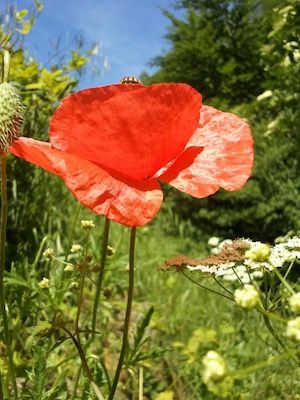CORN POPPY
I- Nomenclature
Latin name: Papaver rhoeas
Family : Papaveraceae
Common names: Common poppy, Corn Poppy, Corn Rose, Field Poppy, Flanders poppy, Red Poppy [1]
II- Legends and traditions
In the language of flowers, the poppy embodies consolation, rest and tranquility.
In French folklore, the poppy wedding symbolizes the 8 years of marriage.
History
The poppy was associated in the twentieth century, in particular in Commonwealth countries (United Kingdom, Canada, Australia, New Zealand, etc.) with the memory of combatants. Poppies bloomed in the worst fields of Somme and Flanders, and their red color was a fitting symbol for the bloodbath of trench warfare.
III- Botanical description
Description: The poppy is an annual plant with a taproot, fibrous, whitish.
The stem, 50 to 70 centimeters, is cylindrical, branchy, erect, fragile, covered with rough hairs.
The leaves, usually sessile and alternate, are cut into narrow, toothed lobes.
The flowers have four slightly crumpled petals that overlap little. Their numerous stamens have bluish-black anthers.
The fruits (not to be confused with the flowers in bud) are hairless, ovoid capsules with poricidal dehiscence containing a large quantity of seeds, easily dispersed by the wind.
Habitat: common in France
Harvest: The poppy prefers calcareous soils especially in harvests. Harvest the petals, taking care to eliminate those that are lighter or very small. Dry them in the shade with great care. Spread them in very thin layers on a mosquito net in a dry, warm and ventilated room. On drying, the flower takes on a darker, wine-red color.
Pars used : Petals
IV- Active ingredients
|
Petals |
|
Anthocyanosides 0.05% alkaloids: rhoeadine Mucilage |
V- Therapeutic uses
Properties
|
Petals |
|
• Softening • Astringent • Calming • Pectoral • Sleeping pill (safe for children) |
Indications
Angina, asthma, bronchitis, whooping cough, colds;
Catarrh;
Colic;
Eruptive fever;
Insomnia.
Dosage
Cataplasm: on inflamed eyelids.
Soft extract: 0.20 to 0.40g per day.
Infusion: 10 to 20gr / liter. Infuse 10 minutes. Drink 3 to 4 cups / day.
Syrup: 200gr of petals in a liter of boiling water. Add 1kg of sugar. Cook until the consistency of syrup is obtained. Take 3 tbsp. per day.
VI- Precaution of use
Contraindication
None known
VII- The suggestion box
Poppy Candy
100g of fresh petals, 200g of sugar.
Pass the petals in a blender and mix them with the sugar.
Pour everything into a non-stick frying pan or saucepan.
Heat everything, stirring constantly until the mixture turns to caramel, stop cooking and pour into a dish. Let cool and cut into small pieces while the caramel is soft. The sweets are ready.



